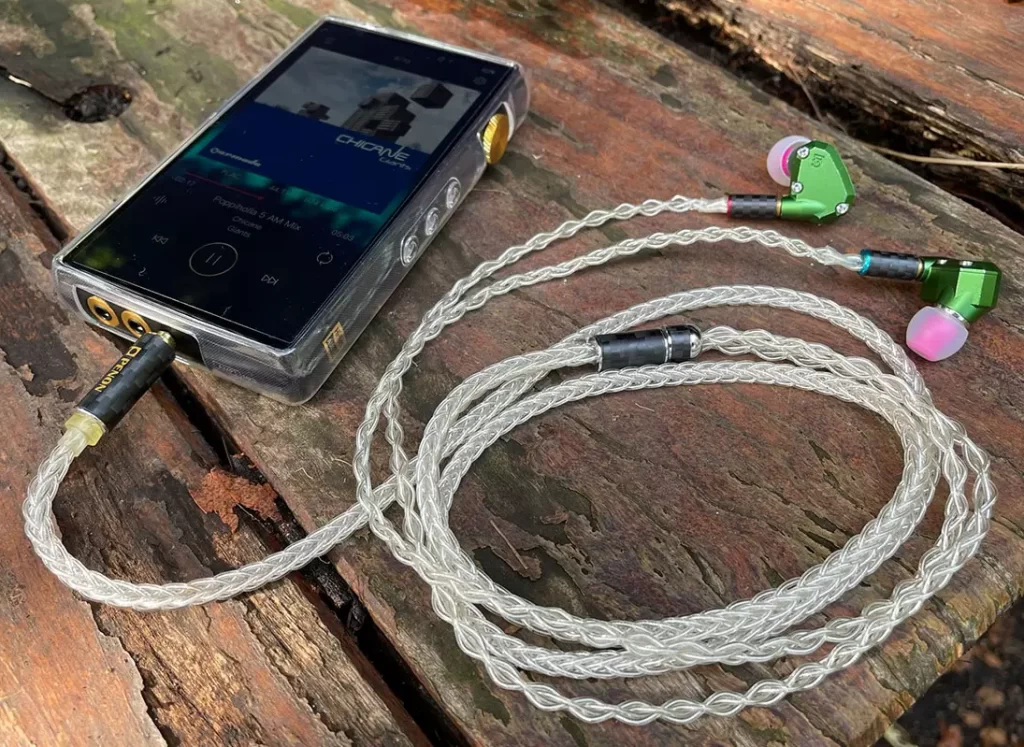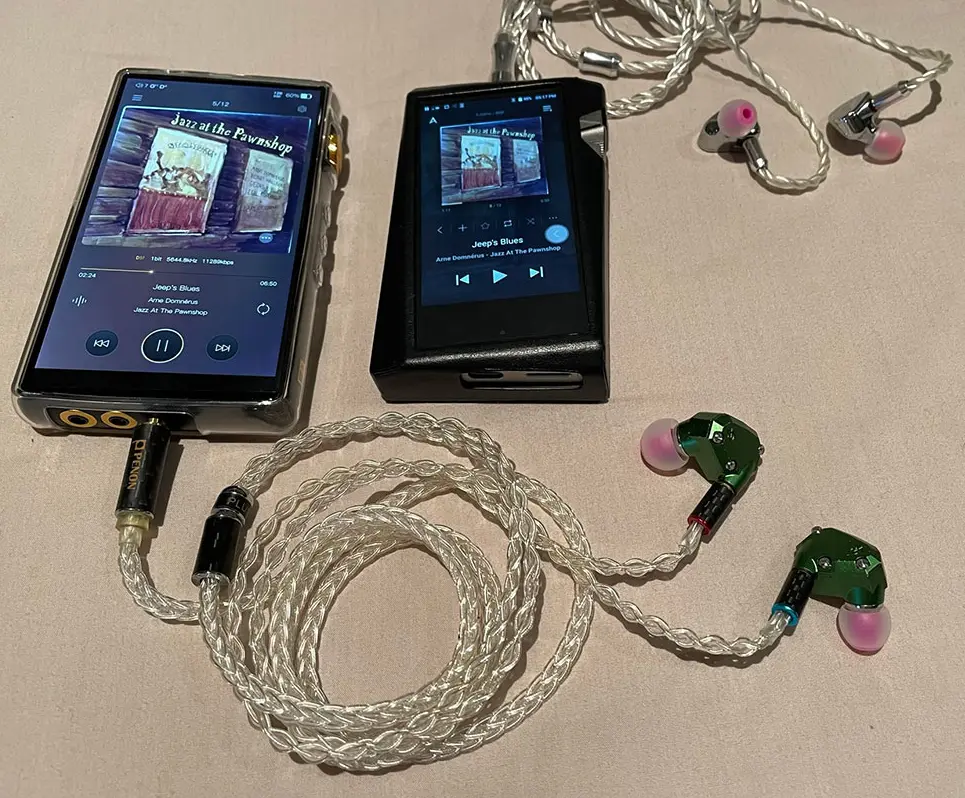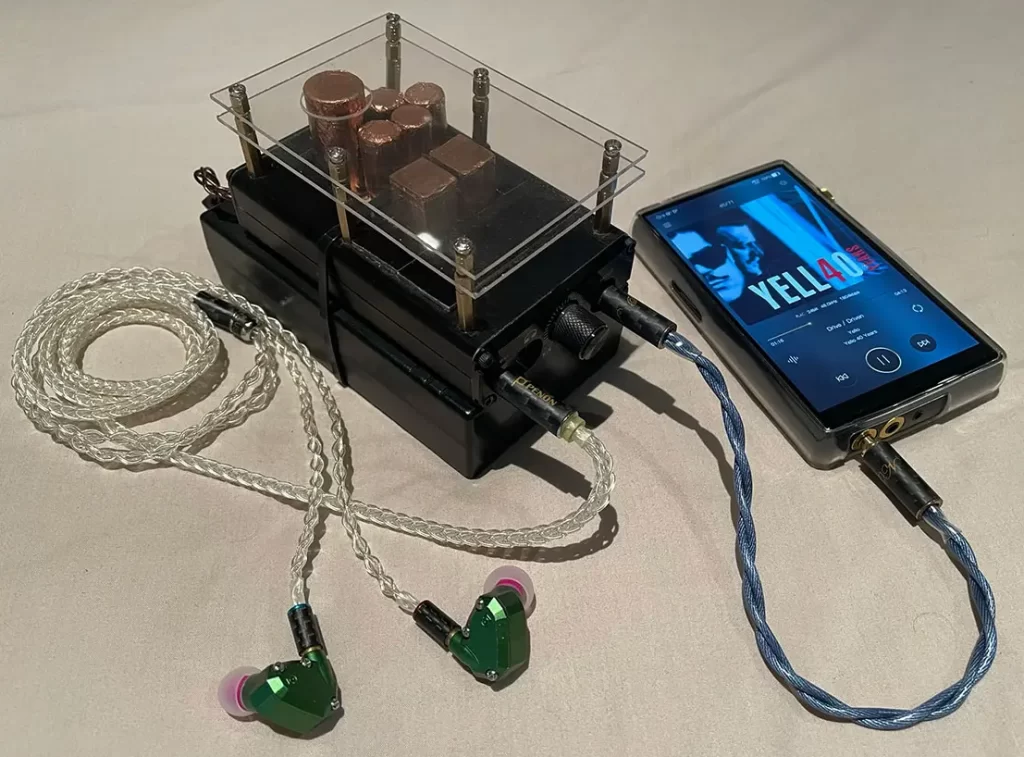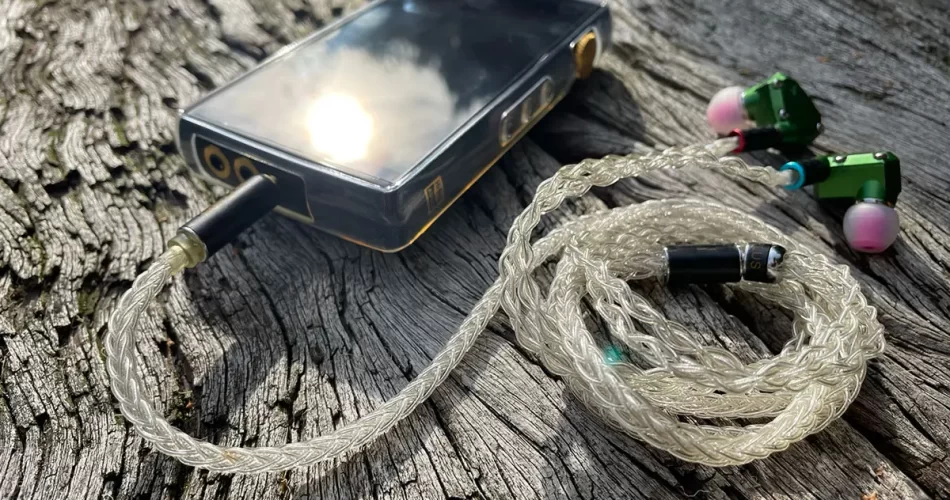iBasso DX240 Review
By Nick Smith, 21th March 2022
Please allow me to begin this review with a short introduction of my own audio background, both for the purpose of giving you some insight into the perspective these comments originate from and the shameless stroking of my own ego.
I was once like you, a young audiophile in search of a dream…
Does that sound a little too self-righteous & sentimental? Not to mention diabolically false since past-tense implies the dream was achieved or abandoned, when those dear to the hobby understand our hearts forever yearn for an ever-receding finish line.
Nonetheless it’s true. I gave up the journey for audio perfection years ago, why go on chasing the impossible when upon hearing the Sennheiser HE-1 I commented on the narrowness of the soundstage – so really what hope is there?
Since the late 90s more money than I care to admit has been blown on this hobby, and over the past decade that cash has been directed exclusively towards portable audio gear & earphones. Perhaps because I work from home & live next door to a kindergarten, just a theory.
So what sort of stuff am I into? Musically, just about anything. I grew up on 80s rock & pop and adore movie soundtracks, but lately spend most of my time digesting electronica, and my album collection is approaching 2,000 despite extensive pruning. Sonically I’m a detail freak. Resolution is my God, though I’ve a confessed fetish for sub bass & cavernous soundstages. IEMs give me what I yearn for most – utter banishment of the need to hunt for detail.
I’ve owned a number of DAPs over the years, beginning with the WM1A, AK380, SP1000M, DX300, and now own the SR25 & DX240 under review. I’ve also previously demoed the WM1Z & SP1000. As for IEMs I own the Andromeda 2020s & Tanchjim Oxygens, and previously owned the Dunu Lunas, Dita Dreams & EE ESRs.
Can We Start The Review Already?
Sure, let’s talk about the DX240. Many of these details you’ll know already but they’ll help get you in the mood for the rest of the review.
It’s a Android-based DAP made by iBasso that retails for around USD $900, features a 5″ screen, 11 hours of battery life, clocks in at a middling 205g, contains a flagship-grade ES9038 DAC, 64GB of onboard storage, dual-band wifi, and swappable amplifier modules like the DX220 before it.
That’s all I’ll be mentioning about the technical hardware aspects of the player. Firstly because I’m incredibly lazy, and second it’s the job of professional reviewers to cover the boring stuff better than I care to. Instead I’ll start off by giving you my impression of everything about the device that DOESN’T concern how it sounds.
Beginning with it’s appearance, the DX240 is an attractive but unspectacular object. As someone who owns the SR25 and has held the WM1Z it takes quite a bit of bling to make me drool, but iBasso’s functionality-first approach is one that’s hard to question.
What’s particularly impressive is the screen. Bezels are tiny by DAP standards, form factor (decently wide but not overly tall) fills a satisfyingly large portion of the screen with album art -in stark contrast to the DX300- and full HD resolution is enough in a screen of this size for ample pixel density.
Ergonomically, I find the DX240 to be the most pleasant DAP I’ve used bar none. With as large a screen as one could want for audio purposes, light enough that it’s genuinely portable, and featuring a rounded back that feels appreciably more comfortable in the hand than a flat-backed DAP. The volume wheel isn’t big enough to look out of place, yet is easy to grip and turns with solid clicks, and the side buttons are distinctively easy to find inside a pocket or the dark but are stiff enough not to get clicked by accident. It’s worth pointing out the main reason I sold the DX300 was its’ size felt impractical in daily use, but that’s definitely not the case here.
My only gripe (as an audiophile there must always be one) is the placement of the output jacks on the bottom rather than the top of the unit. A matter of personal preference to be sure, but I prefer them above so I can rest the DAP base-down on my knee or lap, allowing the IEM cable to drape behind the screen.
Oh, and I should mention the case – the DX240 comes with a TPU rather than a leather case. Some may regard such a lowbrow choice with scorn & dismay, yet I consider it a positive iBasso didn’t squeeze in a low-grade leather case (which many of us would only replace with one from Dignis anyway) whilst staying at their desired pricepoint, or deciding to raise it purely to include a premium leather offering. Moreover I happen to appreciate TPU cases (is it just me?) and this one thankfully lacks the awful stickiness of bargain-basement TPU skins. In fact I’d go so far as to say it serves the purpose flawlessly, and this is coming from a self-confessed Dignis snob.

Software And All That Stuff
Read DAP reviews around here and you’ll find folks endlessly yapping on about SOC’s and why they’re so darn important.
I realize not everyone’s in the position of owning a large music collection and many of you may be largely or even wholly reliant on streaming for your listening pleasure, but I’ve decided not to cover the technical aspects of the DX240’s software architecture because I honestly don’t care.
It’s an Android player that plays music & let’s you install the usual Android apps – what more do you need to know?
Sure I’ll mention the DX240’s 64GB of onboard storage which seems stingy in 2022 but hardly dealbreaking given the price of SD cards. It runs fast enough to perform similarly to a smartphones of a couple of years ago, with wi-fi speeds approaching that of today’s phones, and as for Bluetooth I won’t bother discussing that because I’m an audiophile for God’s sake.
iBasso also includes their own proprietary OS called Mango which is essentially a stripped-down local file music player that supposedly delivers better sound. I’ll talk about that soon because we’re finally done meandering over the technical crap.
Is It A Flagship And Does That Matter
I’m going to keep you on tenderhooks awhile longer while an important point is made. Two of them actually. Firstly, audio performance is a matter of perception and perception is inexorably influenced by psychology. The way you feel about something will affect how you think it sounds since all the data must be fed through an archaic piece of hardware called the human brain, famous for coloring impressions in a multitude of ways our conscious minds are only dimly aware of. Essentially this is a disclaimer that what I hear may be different from what you do, and that’s without even discussing the varying geometry of our ear canals.
Secondly, again on the topic of perception – is the DX240 a “flagship” DAP, does being a flagship DAP matter, and how should a flagship DAP be defined anyway? An article could be written on this point alone but to keep things brief I find the DX240 frustratingly difficult to categorize. On the one hand it isn’t iBasso’s top-of-the-line player, that crown rests with the DX320 now that the DX300 MAX is no longer available. Then there’s the price, considerably below that of modern flagship DAPs, with weight being a similar story. Feature-set & tech specs are in the ballpark of more expensive players, perhaps lagging slightly behind the latest top-end choices but with presumably imperceptible impact on real-world usage.
So we come back to the sound. If it quacks like a flagship, does that make it one? In this hobby that probably depends on your bias. An easy trap to fall into is equating price with performance, we’ve all dug ourselves out of that particular hole at some stage. What’s interesting is how you choose to answer the flagship question may well affect your perception of the DX240’s sound, positively or negatively. So in the interests of full disclosure I personally regard it as a mid-fi DAP that delivers flagship, or at least very close to flagship performance. DX240, the little DAP that could.
How Does It Sound??
These DX240 impressions were gathered via my Andromeda 2020s using a Penon Leo Plus cable, and my Tanchjim Oxygens using a ThieAudio EST cable. Mostly with the Andromedas since they’re a clear step above the Oxygens. Music was taken from a wide swathe of genres – everything from Yello to The Beatles, Ennio Morricone to Nat King Cole, all of it FLAC or DSD with plenty of hi-res. The Mango Player Android app was mostly used, along with a few hours spent in Tidal and the occasional foray into Mango OS.
Put simply this DAP is a rocker, it grooves baby. For years I’ve been growingly disconnected with the rock portion of my album collection, possibly due to a pervading sense rock has never felt less relevant than in today’s strange new world, but to my immense surprise the DX240 has encouraged me to re-connect with all the old favourites. This goes well beyond New Gear Syndrome (the desire to test every familiar album with a newly-acquired piece of kit) and speaks to the sonic character of the DAP itself – one that serves rock music particularly well.
The DX240 is particularly strong on dynamics and fairly aggressive in tone, delivering a somewhat ‘in your face’ presentation. Vocals & guitars are upfront, lacking neither detail nor body. The downside is they can tilt towards shoutiness on occasion, something exacerbated by the Andromedas which have a fairly excited upper midrange. This double-edged sword means there’s copious amounts of detail present throughout the DX240’s frequency spectrum (concentrated in the midrange more than other frequencies) but harshness in an album’s mastering is obscured less than it could be. Detail freaks like me must be careful what we wish for, and this echoes back to the time-honoured value of assembling a collection of high-quality recordings, and crucially weeding out the BADLY mastered albums.
Let’s shift to the lower gears. This DAP is punchy & impactful down low, and will put a smile on your face as you groove to the beat. It has loads of PRAT (pace, rhythm and timing) a term widely used in audiophile circles one more rarely encounters on Head-Fi, perhaps due to the difficulty in quantifying such a thing. Naim & Grado are two brands famous for it, and I happen to rate it particularly highly among audio qualities. If a piece of gear makes me want to get up & dance, regardless of it’s level of articulation it is to some extent doing its’ job of engaging me with the music. I’ve also owned my fair share of cold, sterile equipment that left me feeling emotionally unengaged. The key measure I find is how easy it is to unconsciously listen to an entire album from front-to-back without the urge to switch to something else.
I’ve also come to feel there’s a common link between deep bass, warm sound, and sonic groove. It may even be that excessive detail particularly in the upper frequencies can atrophy PRAT to some degree. Stereotypically, think of the difference between a gold-plated IEM cable that essentially smears notes so they connect together more easily, as opposed to a pure silver cable that etches each one more distinctly and in doing so prevents them blending together in toe-tapping fashion. This is particularly relevant to the DX240, which does a tremendous job of straddling the invisible line between groove and clinical detail. In fact I’ve been greatly impressed by just how much detail it conveys whilst maintaining great rhythm, helping explain why the DAP does so well on a diet of old skool rock – throw on some Creedence and you’ll see what I mean.
So bass is particularly punchy & dynamic, the midrange is very upfront with a slight edge, how about the highs? I wouldn’t say they leave much to be desired, certainly not in terms of resolution, nor do they draw undue attention to themselves. String instruments sound fantastic (evidenced by the 24/192 Conan soundtrack) and electronica is delivered with appropriately satisfying beeps & squeaks. iBasso has avoided overcooking the highs, and only very rarely do I get the impression more upper-frequency emphasis would be beneficial. Having said that I suspect some pricier DAPs out there deliver more distinctively etched highs if that’s something you want prioritized.
Which brings us to technicalities, which are universally excellent and present a strong case for the DX240’s consideration as a flagship-level player. Dynamics are excellent, and are clearly an area where the DX240 is separated from entry & mid-level players. Though I wouldn’t say they approach the levels of spooky realism obtainable with high-end desktop gear, background blackness is excellent and the punchy nature of the low frequencies helps instruments jump out of the mix distinctively. As does the soundstage, which is larger than all my previous DAP’s bar the DX300. That iBasso has achieved a large soundfield whilst maintaining an upfront central midrange image that sufficiently roots attention is something to be commended, as too often gear with large amounts of groove comes with a narrow soundstage price of entry – that’s definitely not the case here. Finally, imaging is spectacularly good and this is something the Andromeda 2020’s particularly enhance. Orchestral works avoid feeling congested, as the soundscape is particularly wide and appreciably deep. In short the DX240 delivers enough technical goodies to not feel out of place in high-end company.
Lastly the DX240 offers a few ways to tweak sound, the first are digital filters. At the risk of killing my audio street-cred I’ve strained my ears to hear a difference between these but have come up empty. The second is Mango OS, which admittedly sounds slightly different to the Android Mango player. Mango OS may be slightly more transparent & dynamic, the problem is it takes a good 20 or 30 seconds to switch between the two and sonic memory is so short an effective A/B comparison is nigh-impossible unless you happen to have two identical DAPs on hand – and even then you’d need to consider if one is more burned-in than the other. So generally I use the Android Mango player purely because scrolling on Mango OS is so stupidly fast I find the experience extremely frustrating. A shame because it may indeed sound a little better. Next, the DX240 features three gain levels. It may surprise some of you to hear I use the 878mW High Gain mode exclusively, even with the Andromeda 2020’s which are one of the easiest earphones in existence to drive – the higher the gain level the more dynamics improve & the more the bottom-end is emphasized, which suits my listening preference. There’s also the removable amp modules, but as I only possess the stock AMP1MK3 I’ve no comment to make on those yet.

Astell & Kern SR25 Comparison
Admittedly this isn’t the world’s fairest comparison, but I’ve nothing else of audiophile note to compare the DX240 against right now so it’ll have to do. A flimsy justification may be they’re two DAPs on the smaller side of the spectrum, with 64GB of storage, and they both run on electricity. Who are we kidding here – you probably expect the DX240 to trounce its’ opponent and you’d be absolutely correct.
To give the SR25 it’s due, it is considerably smaller, lighter and cheaper. It’s also drop-dead gorgeous looking. What I’ve always felt particularly holds it back sonically is how flat it can sound, there’s a lack of dynamism and a certain muddiness which reveals itself when compared with the DX240. The iBasso DAP provides a much better sense of separation with a wider soundstage, a deeper bottom-end, and a greater sense of sonic refinement. I feel like the DX240 is more V-shaped than the SR25 (but you wouldn’t call it V-shaped in a general sense) whereas the SR25 is more midrange-centric with Astell & Kern’s signature coloration that seems to be a love-it-or-hate-it thing for many.
After saying that there isn’t as big a gulf between the two as you might think. Others have said the difference between DAPs is more subtle compared with say earphones, or perhaps even cables (yes I went there), and I echo that sentiment. I can listen to the Andromeda 2020’s on the SR25 and genuinely feel like I’m missing out on very little, but after switching to the DX240 every instrument & voice is that little bit more distinct, and the larger soundstage gives the performance more room to breathe. The difference between the two DAPs is immensely less than the gap between the Andromeda’s and the Oxygen’s though, ultimately the SR25 & DX240 sound far more alike than unlike.
The difference in usability however is stark. The SR25’s tiny 3.6″ screen is one of the main reasons I now own the DX240. Its’ wimpy CPU and terrible wi-fi performance makes using Tidal a chore, whereas the DX240 delivers a modern smartphone-esque experience. In saying that, the SR25 does pack an awful lot of DAP into a tiny package. Unfortunately since purchasing Airpod Pros that no longer seems quite so important since whenever I want to listen portably in truly minimalist fashion I’ll grab those instead, particularly in situations where the drone of public transport will drown out most of the sound quality anyway. Does this also affect how I feel about the DX240’s portability over something like the DX300? To a small extent, though the DX300 always felt awkward to hold & use whereas the DX240 feels moulded to my hand – the fit is simply perfect, something which positively colors my experience everytime I use it.

Adding An External Amplifier
Those of us older folk may have experienced a time when we began using mobile phones and immediately felt going back to being anchored to a landline was impossible. I have a similar feeling towards portable audio compared with high-end desktop headphone gear. The joyously minimalist experience of a single pair of transducers, a solitary cable and a tiny portable source is something I have trouble giving up now, and if you’re reading this review you may feel similarly. What many Head-Fiers seem to assume is that flagship DAPs will automatically extract maximum performance from their IEMs – I’m afraid to tell you that simply isn’t the case.
IEMs, even those solely BA-based like my Andromeda 2020’s may be easy to drive that’s true. Unfortunately, you’re simply kidding yourself if you think something small enough to fit in your hand can contain enough quality circuitry to drive them to their absolute limit. Let’s be clear about this – I’m not suggesting a device like the DX240 isn’t capable of driving the Andromeda 2020’s, or any IEM’s I own (yes including you Blon-BL03s) in a completely satisfying manner, enough to provide a quality listening experience for any discerning audiophile.
What I am saying is this: I don’t care which DAP you own or how much you spent on it, the laws of physics dictate unless you add an external amp you’re leaving IEM performance improvements on the table, or desktop as the case may be. In fact I’d be shocked if it isn’t possible to boost high-end IEMs even further (possibly a LOT further) by using a high-end desktop amp. What sense it would make listening to PORTABLE earphones through an extremely heavy, extremely un-portable desktop amp is another question, which is probably why few of us do – returning to my earlier point about the joy of a truly portable setup that can be enjoyed anywhere.
However, adding something like a Cayin C9 or Woo Audio WA8 will benefit your IEM setup more than many Head-Fiers like to believe. So with that in mind naturally I’ve tested the DX240 with my own heavily-modified Little Bear B4-X tube amp which you can read about here.
To give you some background, I modded the B4-X in every way my limited electronics knowledge can envisage and generally used the most expensive parts available. Sonically it now resembles the stock B4-X about as much as it looks, delivering superb desktop-class performance. The midrange in particular is astonishingly transparent, far TOO transparent for poor recordings where absolutely nothing is concealed.
So how does the DX240 compare with & without the amp? The biggest difference lies in the soundstage. Listening straight out of the DX240 the soundstage is extremely impressive by DAP standards, but after hooking up the modded B4-X you realize how narrow & congested it is by comparison. Everything expands outwards with a sense of grandness I’ve never heard directly from any DAP, resolution improves -particularly in the highs- and refinement goes up a couple of notches. Everything feels significantly more relaxed and less edgy, yet details require even less effort to pick out. The sonic flavor changes however, with instruments having significantly less body but more air, and overall less emphasis on the lower frequencies. This lends itself to a more contemplative atmosphere, rather than one encouraging you to jump up & dance. A more cerebral experience, yet one providing even greater emotional connection to the music.
However one downside of the B4-X is it’s always been a fairly noisy amp, which the mods have never truly eliminated. Not only is background blackness better direct from the DX240, but the B4-X produces a very quiet yet annoying background clicking sound which persists until the amp has warmed up for a considerable period – more than an hour, which is also how long it takes the tubes to sound their best. So I find adding the B4-X is great for extended desk-bound listening sessions but not worth plugging in if I’m listening to a handful of songs, particularly on the go. Lastly it’s worth mentioning interconnect quality is important – adding the Penon Totem cable upgraded performance considerably in an immediately obvious way.
Conclusion
The DX240 isn’t perfect. Nothing is. The question remains if we should consider it a flagship player or not, and you’ll have to formulate your own answer to that. What I can tell you is that for its’ size, weight and price the DX240 offers more sonic performance than just about any DAP on the market in 2022. It’s a player that’ll make you move & grove, yet still offer enough audiophile refinement to feel like you’re missing nothing each recording has to offer.
I strongly endorse this player, and have been a touch surprised by how little hype it has garnered in the community thus far. My suspicion is because so much perception of quality in this hobby is tied to price and flagship status, everyone wants “the best” for psychological reasons and the perception the DX240 isn’t even “the best” in iBasso’s own product lineup may be holding people back.
There’s no absolutely regrets here that I slimmed down from the brick that was the DX300, in fact the DX240 suits my sonic preferences even better and has helped my rediscover my rock-loving roots. Small, powerful & sonically superb, what’s not to love?


Comments